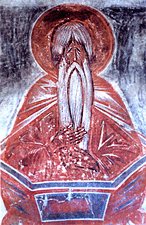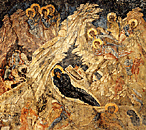 |
|
 |
Painting: 1360-1400
 he painting of the end of the century
he painting of the end of the century
 is characterised by eclecticism, a return to the aesthetic quests of the early years, and at the same time by a tendency towards a simplification and stylisation of expressive means. The katholikon of the monastery of the Virgin Peribleptos at Mistra may be characterised as the most important monument of this period. Built on the edge of the late-Byzantine city and most probably founded by the despotes
Manuel Kantakouzenos (1348-1380),
it contains
an exquisite painting ensemble dated to around 1360-1370. The painting style of the Peribleptos monastery is that of the monuments of the first two decades of the 14th century, such as the frescoes of the Chora monastery in Constantinople and of the church of the Holy Apostles in Thessalonike. The refined, delicate figures, so elegant and graceful in their movements and attitudes, the simple, everyday scenes, such as that of the children playing, in the painting of the Entry into Jerusalem, constitute the characteristic featuresof the frescoes. A similar trend, is characterised by eclecticism, a return to the aesthetic quests of the early years, and at the same time by a tendency towards a simplification and stylisation of expressive means. The katholikon of the monastery of the Virgin Peribleptos at Mistra may be characterised as the most important monument of this period. Built on the edge of the late-Byzantine city and most probably founded by the despotes
Manuel Kantakouzenos (1348-1380),
it contains
an exquisite painting ensemble dated to around 1360-1370. The painting style of the Peribleptos monastery is that of the monuments of the first two decades of the 14th century, such as the frescoes of the Chora monastery in Constantinople and of the church of the Holy Apostles in Thessalonike. The refined, delicate figures, so elegant and graceful in their movements and attitudes, the simple, everyday scenes, such as that of the children playing, in the painting of the Entry into Jerusalem, constitute the characteristic featuresof the frescoes. A similar trend,
 which, however, is carried to the point of mannerism and exaggerated elegance, and emphasises the decorative element, may be found in a series of monuments in Serbia, in the region of the Morava. At the other extreme of this lyrical and decorative artistic trend is observable a current of such dynamism and expressive strength that it is often described as expressionistic. The frescoes of St Nicholas at Platsa in the Mani (1337/8) are the forerunners of this trend, while other characteristic examples are the wall paintings in Ivanovo in Bulgaria, a gift of Tsar Alexander (1331-71), and the works of Theophanes the Greek, a painter from Constantinople, who worked in Novgorod and Moscow. A freedom of line, tints that lend vivacity to the faces, the absence of outlines, impart to these works a dreamlike dimension. which, however, is carried to the point of mannerism and exaggerated elegance, and emphasises the decorative element, may be found in a series of monuments in Serbia, in the region of the Morava. At the other extreme of this lyrical and decorative artistic trend is observable a current of such dynamism and expressive strength that it is often described as expressionistic. The frescoes of St Nicholas at Platsa in the Mani (1337/8) are the forerunners of this trend, while other characteristic examples are the wall paintings in Ivanovo in Bulgaria, a gift of Tsar Alexander (1331-71), and the works of Theophanes the Greek, a painter from Constantinople, who worked in Novgorod and Moscow. A freedom of line, tints that lend vivacity to the faces, the absence of outlines, impart to these works a dreamlike dimension.
See also: Chora monastery
Church of the Holy Apostles
Mistra,
Peribleptos
|